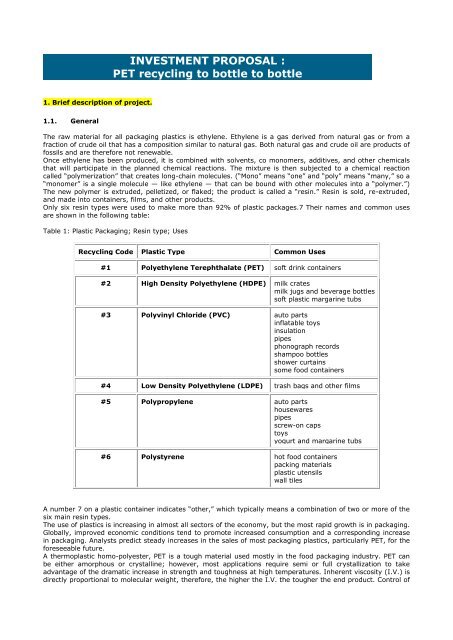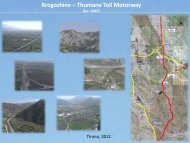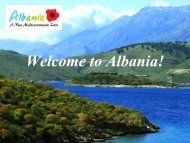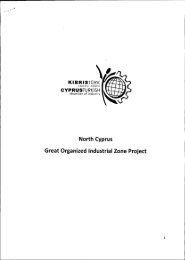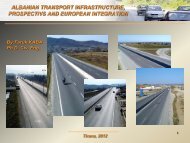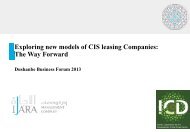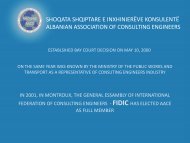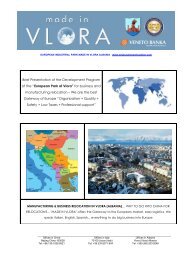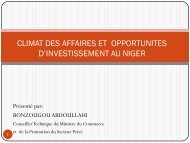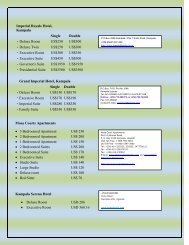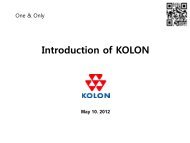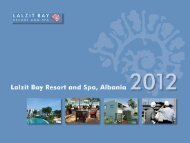PET Recycling to Bottle - IDB Group Business Forum
PET Recycling to Bottle - IDB Group Business Forum
PET Recycling to Bottle - IDB Group Business Forum
- No tags were found...
You also want an ePaper? Increase the reach of your titles
YUMPU automatically turns print PDFs into web optimized ePapers that Google loves.
INVESTMENT PROPOSAL :<strong>PET</strong> recycling <strong>to</strong> bottle <strong>to</strong> bottle1. Brief description of project.1.1. GeneralThe raw material for all packaging plastics is ethylene. Ethylene is a gas derived from natural gas or from afraction of crude oil that has a composition similar <strong>to</strong> natural gas. Both natural gas and crude oil are products offossils and are therefore not renewable.Once ethylene has been produced, it is combined with solvents, co monomers, additives, and other chemicalsthat will participate in the planned chemical reactions. The mixture is then subjected <strong>to</strong> a chemical reactioncalled “polymerization” that creates long-chain molecules. (“Mono” means “one” and “poly” means “many,” so a“monomer” is a single molecule — like ethylene — that can be bound with other molecules in<strong>to</strong> a “polymer.”)The new polymer is extruded, pelletized, or flaked; the product is called a “resin.” Resin is sold, re-extruded,and made in<strong>to</strong> containers, films, and other products.Only six resin types were used <strong>to</strong> make more than 92% of plastic packages.7 Their names and common usesare shown in the following table:Table 1: Plastic Packaging; Resin type; Uses<strong>Recycling</strong> Code Plastic Type Common Uses#1 Polyethylene Terephthalate (<strong>PET</strong>) soft drink containers#2 High Density Polyethylene (HDPE) milk cratesmilk jugs and beverage bottlessoft plastic margarine tubs#3 Polyvinyl Chloride (PVC) au<strong>to</strong> partsinflatable <strong>to</strong>ysinsulationpipesphonograph recordsshampoo bottlesshower curtainssome food containers#4 Low Density Polyethylene (LDPE) trash bags and other films#5 Polypropylene au<strong>to</strong> partshousewarespipesscrew-on caps<strong>to</strong>ysyogurt and margarine tubs#6 Polystyrene hot food containerspacking materialsplastic utensilswall tilesA number 7 on a plastic container indicates “other,” which typically means a combination of two or more of thesix main resin types.The use of plastics is increasing in almost all sec<strong>to</strong>rs of the economy, but the most rapid growth is in packaging.Globally, improved economic conditions tend <strong>to</strong> promote increased consumption and a corresponding increasein packaging. Analysts predict steady increases in the sales of most packaging plastics, particularly <strong>PET</strong>, for theforeseeable future.A thermoplastic homo-polyester, <strong>PET</strong> is a <strong>to</strong>ugh material used mostly in the food packaging industry. <strong>PET</strong> canbe either amorphous or crystalline; however, most applications require semi or full crystallization <strong>to</strong> takeadvantage of the dramatic increase in strength and <strong>to</strong>ughness at high temperatures. Inherent viscosity (I.V.) isdirectly proportional <strong>to</strong> molecular weight, therefore, the higher the I.V. the <strong>to</strong>ugher the end product. Control of
acetaldehyde (AA) levels in bottle grade materials is of primary importance. <strong>PET</strong> is very hygroscopic andunstable in the presence of H2O; therefore, it must be dried intensively before processing.1.2. Reusing conceptReusing containers is one of the most effective and inexpensive ways <strong>to</strong> reduce the environmental impact ofpackaging. Some plastic containers can be made durable enough <strong>to</strong> be refilled and reused about 25 timesbefore becoming <strong>to</strong>o damaged for reuse. Refilling and reusing plastic containers directly reduces the demandfor disposable plastic.Accordingly, lowering demand for single-use containers reduces waste and energy consumption. Based on 2005data, if glass and <strong>PET</strong> bottles were refilled and reused 25–35 times, the overall weight of beer and soft drinkcontainer waste would be reduced by 73.6%. Significant reductions in waste and energy consumption can beachieved with just 7–8 reuses of a single bottle.One <strong>to</strong>xicity study investigating the use of <strong>PET</strong> for refillable bottles tested various <strong>to</strong>xic substances <strong>to</strong> see ifthey would be absorbed in<strong>to</strong> the <strong>PET</strong> plastic during one use, then released in the next use. After testsubstances were removed and the plastic washed, the bottles were filled with food, and the contents wereanalyzed. The analysis showed that none of the test substances was absorbed in<strong>to</strong> the <strong>PET</strong>. This studyconcluded that <strong>PET</strong> could be considered as a practical candidate for refillable containers. As discussed above,migration of additives from the <strong>PET</strong> itself is still a problem.As applied <strong>to</strong> plastic packaging, primary reprocessing produces new packaging; secondary reprocessingproduces new items that are usually not practically recyclable themselves because of reduced polymer purityand the lack of collection infrastructure; tertiary reprocessing uses high heat or industrial chemicals <strong>to</strong> breakplastic products in<strong>to</strong> their chemical components, some of which can then, in theory, be made in<strong>to</strong> newproducts.
Figure 1: Comparison of Material Flows with Alternative Disposal SchemesIn theory, all six of the six resin types used <strong>to</strong> make packaging plastics are candidates for primary reprocessing.In reality, however, primary reprocessing is rare.Two chemical properties make it difficult. One is plastic’s sensitivity <strong>to</strong> heat and handling. Plastic molecules arelong and flexible, and they change structurally when subjected <strong>to</strong> thermal and mechanical stress during meltingand extrusion. The molecules interconnect and stiffen, and the plastic becomes weak and brittle. This type ofdegradation is called “heat his<strong>to</strong>ry” in the plastics recycling trade. The deterioration accumulates with eachreprocessing and is irreversible.The second chemical property that makes primary reprocessing difficult is that plastics are very susceptible <strong>to</strong>contamination. If sorting is imperfect, resins may mix with other kinds of organic debris when melted.Mixing leads <strong>to</strong> defects and disruptions in the molecular structure which, in turn, leads <strong>to</strong> degraded properties.In some cases, contamination leads <strong>to</strong> the <strong>to</strong>tal breakdown of the polymer. For example, even trace amountsof polyvinyl chloride (PVC) destroy polyethylene when the two are melted <strong>to</strong>gether.With plastics, however, potential contaminants are more plentiful and much more difficult <strong>to</strong> control. Separatingplastics is particularly problematic because there is little variation in physical properties (such as density andsolubility) <strong>to</strong> use in sorting. Also, the six basic types of plastic resin include multiple grades and colors withineach resin type, and often several resin types are used <strong>to</strong> make a single container.Primary plastics reprocessing is therefore strongly limited by the chemical properties of the material.Reprocessors that make plastic containers out of other plastic containers typically blend virgin resin with therecycled resin <strong>to</strong> boost the product’s performance. One study reported that it is possible <strong>to</strong> make containerswith recycled contents of up <strong>to</strong> 50%, if the reclaimed containers used are themselves made of pure virgin resin.At least one blow-molder was also able <strong>to</strong> produce a 100%-recycled content bottle with the desired propertiesusing a particular blend of postconsumer resins. However; large-scale reprocessors have found that using morethan 15% <strong>to</strong> 25% of post-consumer feeds<strong>to</strong>ck reduced the strength of their containers.1.3. <strong>Recycling</strong> <strong>PET</strong><strong>PET</strong> recycling seems feasible in two aspects: one is that is the market need and second this market need is justat the same direction with the environmental request <strong>to</strong> reduce the waste materials in the land fields or thewaste in general.The <strong>PET</strong> recycling produces <strong>PET</strong> resin <strong>to</strong> be used for bottle <strong>to</strong> bottle, fiber and film forming. These are the endprocesses of the <strong>PET</strong> recycle if we do not consider <strong>to</strong> process it further in secondary and tertiary processesdescribed briefly above.Our project is considering the <strong>PET</strong> recycling for the final product <strong>to</strong> the bottle <strong>to</strong> bottle. The project itself wouldbe realized in the following steps:
1. Collection of the <strong>PET</strong> bottles and process <strong>to</strong> <strong>PET</strong> bottle bales,2. Process of <strong>PET</strong> bottle bales <strong>to</strong> <strong>PET</strong> flakes;3. Process the <strong>PET</strong> flakes <strong>to</strong> <strong>PET</strong> granules;4. Process the <strong>PET</strong> granules <strong>to</strong> <strong>PET</strong> bottles;Each step is cost evaluated and the feasibility in each process is estimated. The first phase that is the collectionof the <strong>PET</strong> bottles would start first in order <strong>to</strong> create the raw material <strong>to</strong> be processed in the next steps.Although the <strong>to</strong>tal cost investment is estimated <strong>to</strong> be around 2.5-3 million euro, the project itself would utilizethe financing step by step and have promising parameters <strong>to</strong> be financed by crediting itself.The <strong>to</strong>tal project itself is considered <strong>to</strong> be realized in three stages: the first stage of preparing the <strong>PET</strong> flakes <strong>to</strong>the food grade quality (that includes step 1 and 2), the second stage that process <strong>PET</strong> flakes <strong>to</strong> <strong>PET</strong> granulesthrough the process of change of intrinsic viscosity known as IV fac<strong>to</strong>r and <strong>PET</strong> crystallization and cut <strong>to</strong>granules, and the final stage that makes <strong>PET</strong> bottles from granules obtained from the second stage andadditional virgin material.Albania, Kosovo and Macedonia are collecting <strong>PET</strong> bottles but they do not process it further. Only in Albaniathere is a potential of being collected about 6000 <strong>to</strong>n of <strong>PET</strong> bottles, which is only a small part of the <strong>PET</strong>bottles that waste. In Albanian market is a supply of more than 300 <strong>to</strong>n/month that sales outside and Kosovowith Macedonia provide <strong>to</strong>gether more than 400 <strong>to</strong>n/month. The actual estimated supply in Albania is 3600<strong>to</strong>n/year.2. Sponsorship, management & technical assistance:2.1. His<strong>to</strong>ry and business of sponsors, including financial information.In Albania the <strong>PET</strong> recycling is not introduced yet. According <strong>to</strong> statistical data there could be about 6000<strong>to</strong>n/year of <strong>PET</strong> bottles that could be collected. The municipality still is not encouraging the collection of thetrash materials in separate trash bins although a tax for cleaning garbage is collected. If partially this tax couldbe used <strong>to</strong> finance this project or similar recycling projects, the local government could be a target sponsor forsuch activity.2.2. Proposed management arrangements and names and curricula vitae of managers.The <strong>PET</strong> recycling requires 2.5 – 3 million euros <strong>to</strong> cover all the stages of recycling and process R<strong>PET</strong> <strong>to</strong> bottle<strong>to</strong> bottle. The private company “Henry 2000” is a well known company in sanitarian materials being a leader inthis types of supply provided through imports from China and other countries as well as by having in theregional market the brand names products of the company. The regional sale market includes Albania, Kosova,Montenegro, Macedonia and extends as well in EC countries like Italy and France.Mr.Ylli Xhakollari, is the owner of the company “Henry 2000” and owns it as a single owner. During 15 years ofwork the company is increased rapidly having a capital of some million Euros and the share of the sanitariangoods about 80%. The <strong>to</strong>tal capital cost of company is estimated <strong>to</strong> be worth of 8 million euro.Considering the environmental impact of introducing the <strong>PET</strong> recycling, the company would like <strong>to</strong> be involvedand realize this project based in the analyze of success s<strong>to</strong>ry of the company management.2.3. Description of technical arrangements and other external assistance (management,production, marketing, finance, etc.).The company has finalized the feasibility study of the project. During this study the company is consulted withengineers and technicians as well as with organisms that are responsible for environment like Ministry ofEnvironment and Regional Agency of Environment, and the local government.Regarding the technological process and equipments the company has made contacts and offer requirements <strong>to</strong>the leader companies in producing technological <strong>PET</strong> recycling lines in EC and in China. The selection of the bes<strong>to</strong>ffer is made for the lowest evaluated offer that meets both bottle <strong>to</strong> bottle requirements as well asenvironmental requirements.The product from the first stage of the project is <strong>PET</strong> flakes that are on demand from markets in EC and Asia.On this stage seems that the product would be sold successfully and cover in reasonable time the initialinvestment and generate funds for developing the next stages of the project.
The financing of the whole project would require 2.5 – 3 million euros in three stages that are <strong>PET</strong> recycling <strong>to</strong><strong>PET</strong> flakes food quality, <strong>PET</strong> flakes crystallized <strong>to</strong> <strong>PET</strong> pellets and <strong>PET</strong> pellets extruded <strong>to</strong> bottle flacons andbottles for food purpose. This is the complete recycle of <strong>PET</strong> <strong>to</strong> bottle <strong>to</strong> bottle processes. The company wouldlike <strong>to</strong> start first with the <strong>PET</strong> recycling <strong>to</strong> <strong>PET</strong> flakes that meet the first grade quality. This product is highlyrequired in the market and also creates a good link for the second and third step of the whole project. Becausethe company is big and in the present business it operates in the high rate of the cash flow, crediting by thebank is the first option in developing the project stages. Therefore the company is looking <strong>to</strong> the banks andother financial institutions that would like <strong>to</strong> be involved with credit financing in the project.3. Market & sales:3.1. Basic market orientation: local, national, regional, or export.The latest data from <strong>PET</strong> recycling EU organisation Petcore shows that 40% of all <strong>PET</strong> bottles introduced <strong>to</strong> theEuropean marketplace were collected for recycling in 2007 – a 20% increase on the previous year. Theassociation says that European post sorting <strong>PET</strong> collection reached 1.13m <strong>to</strong>nnes last year. Petcore said therewas an overall estimated <strong>to</strong>tal mechanical reclamation capacity in the European region of 1.2m <strong>to</strong>nnes in 2008,with approximately 100,000 tpa of extra capacity planned.In Albania the collection of <strong>PET</strong> bottles has started and is located <strong>to</strong> two or three companies that simply collect,pre select and process used <strong>PET</strong> bottles <strong>to</strong> <strong>PET</strong> bottle bales with max 300 kg/m 3 . Bales are wired by metal wireor strap and make a shape of minimum dimensions 700x800x700 mm up <strong>to</strong> the maximum 800x1200x1000mm. According <strong>to</strong> ITC (International Trade Statistics) the value of waste plastics of all kinds in Albania for years2001-2005 was 3.29, 4.35, 4.39, 3.18 and 2.03 million dollars. And in all sorts of plastics <strong>PET</strong> and HDPE coversabout 95% of the <strong>to</strong>tal quantity.Tirana, Durresi, Vlora, Shkodra, Fieri, Elbasani, Korca are the cities with most consume of soda water and allthe commodities packed in the <strong>PET</strong> bottle. In these cities we have calculated that will get 90% of <strong>PET</strong> recycledbottles.The bottle collection is managed basically in the city waste land fields. Is less collection made in the clean <strong>PET</strong>recycled that would be collected directly in the main consumers place.All the <strong>PET</strong> bottle collec<strong>to</strong>rs export their product <strong>to</strong> Bulgaria and Italy.3.2. Projected production volumes, unit prices, sales objectives, and market share of proposedventure.Considering that the rate of <strong>PET</strong> collection is still unknown and comparing with the data of the EU hitting <strong>to</strong>40% collection rate, the capacity of the <strong>PET</strong> flake line would be 800-1000 kg/hour. Assuming 50 weeks of workon 24/24 for 7 days, and the efficiency of 80%, the line capacity is optimized <strong>to</strong> be 1000 kg/hour that is aninput of 5000 <strong>to</strong>n/year or output of 4000 <strong>to</strong>n <strong>PET</strong> flakes of food grade.a. The units prices considered for the first phase, collecting <strong>PET</strong> bottles and process <strong>to</strong> <strong>PET</strong> flakes are:- <strong>PET</strong> bottles in bail 300 USD/<strong>to</strong>n- working labor 50 USD/<strong>to</strong>n- electricity 50 USD/<strong>to</strong>n- depreciation cost 20 USD/<strong>to</strong>n- <strong>to</strong>tal cost 420 USD/<strong>to</strong>nb. The unit prices considered for the second phase, processing <strong>PET</strong> flakes in granules and viscosity change are:- <strong>PET</strong> flakes 600 USD/<strong>to</strong>n- working labor 10 USD/<strong>to</strong>n- electricity 50 USD/<strong>to</strong>n- depreciation cost 40 USD/<strong>to</strong>n- <strong>to</strong>tal cost 700 USD/<strong>to</strong>nc. The unit prices considered for the second phase, processing <strong>PET</strong> granules <strong>to</strong> <strong>PET</strong> bottels are:
- <strong>PET</strong> granule 1000 USD/<strong>to</strong>n- working labor 10 USD/<strong>to</strong>n- electricity 50 USD/<strong>to</strong>n- depreciation cost 40 USD/<strong>to</strong>n- <strong>to</strong>tal cost 1100 USD/<strong>to</strong>nSales objectives are based on the market price search of products such <strong>PET</strong> bales, <strong>PET</strong> flakes, <strong>PET</strong> granules and<strong>PET</strong> bottles. On our project these objectives are evaluated for each step along with net profit.a. First phase: <strong>PET</strong> flakes- <strong>PET</strong> flakes cost 420 USD/<strong>to</strong>n- <strong>PET</strong> flakes sell 600 USD/<strong>to</strong>n- Net difference 180 USD/<strong>to</strong>nb. Second phase: <strong>PET</strong> granule- <strong>PET</strong> granule cost 420 USD/<strong>to</strong>n- <strong>PET</strong> granule sell 700 USD/<strong>to</strong>n- Net difference 280 USD/<strong>to</strong>nc. Third phase: <strong>PET</strong> bottle cylinder- <strong>PET</strong> bottle cylinder cost 1100 USD/<strong>to</strong>n- <strong>PET</strong> bottle cylinder sell 2000 USD/<strong>to</strong>n- Net difference 900 USD/<strong>to</strong>nPrices for recycled <strong>PET</strong> will continue <strong>to</strong> be tied very strongly <strong>to</strong> the fate of virgin <strong>PET</strong>. In the coming decades,the <strong>PET</strong> industry will have <strong>to</strong> choose among several options for meeting the apparent persistent rise in <strong>PET</strong> use:by adding virgin capacity, by participating in recovering more discarded <strong>PET</strong>, or by some combination of thetwo. Continued low recovery rates for <strong>PET</strong> may force states and governments <strong>to</strong> add pressure in making thatdecision.3.3 Potential users of products and distribution channels <strong>to</strong> be used.There are potential users of <strong>PET</strong> recycled products for each phase. In recycling the smallest net difference staysin <strong>PET</strong> bottle collection <strong>to</strong> make <strong>PET</strong> bottle bails. Because the market supply of the EU is up <strong>to</strong> 40% with <strong>PET</strong>recycled the demand from <strong>PET</strong> flakes producers byes the <strong>PET</strong> bottle bails. The project would start firstaccumulating <strong>PET</strong> bottle bails <strong>to</strong> prepare the market and be prepared for the shortage of supply duringproduction.Because of cost expensive processes of producing virgin <strong>PET</strong> material and the ecological laws that obliges thecountries <strong>to</strong> process their waste, the investment for establishing <strong>PET</strong> recycling <strong>to</strong> <strong>PET</strong> flakes are feasible.Potential users of <strong>PET</strong> flakes are the EU countries like Italy and Germany that already are working in thirdphase of <strong>PET</strong> processing by changing intrinsic viscosity (IV) and crystallization of recycled <strong>PET</strong> flakes <strong>to</strong> the finalproduct such as <strong>PET</strong> granule and <strong>PET</strong> bottle cylinders. COCA COLA and PEPSI are the main companies thatconsume huge quantities of <strong>PET</strong> recycled material <strong>to</strong> make new bottles for their production.In Albania we see potential users of our final product the mineral and soda water companies that are always inneed for confectioning their product in bottles. Also the increase of the local production of beer makes strongerdemand in the local market for the plastic bottles made with <strong>PET</strong>.The evaluation of the offer and demand for <strong>PET</strong> resine in the region, EU and China makes the sale of theproducts in each phase feasible.3.4. Present sources of supply for products.
Present sources of supply we have considered <strong>to</strong> start are the waste collec<strong>to</strong>rs working in the land fields of themain cities of Albania. Beside other materials they collect and bail <strong>PET</strong> bottles. Through the network sale tha<strong>to</strong>ur company has established in long working years, the company is planning <strong>to</strong> provide in the main collectionplaces the pressing and bailing machines. The same scheme we plan <strong>to</strong> use for the regional collecting. Thereare companies in Kosovo and Macedonia already collecting and interested <strong>to</strong> sale their product. Also in Greece,Thessaloniki seems <strong>to</strong> be an interesting source until the Albanian market of the <strong>PET</strong> collection would gostronger.3.5. Future competition and possibility that market may be satisfied by substitute products.Bottling of liquid food materials uses mainly the confection in <strong>PET</strong> bottles, glass bottles and tetra pack.However, tetra pack could not be used for confectioning liquids such are water, gas water, juices, Coca Colaand Pepsi, food oils, etc, where the visibility of the color and clearance of the liquid counts on the taste andselection of the buyer. Therefore tetra pack also for the future seems <strong>to</strong> be no competi<strong>to</strong>r.However, in question is the use of the <strong>PET</strong> versus the glass. The technical studies show that the energyconsumed <strong>to</strong> make glass confection or <strong>PET</strong> confection are quite equally. Beside the glass bottles are technicallyrecycled only by washing and not reforming like <strong>PET</strong> resins. Development and research made for <strong>PET</strong> recyclingis providing more energy efficient technologies like Vacurema, that process the recycled <strong>PET</strong> resins in thefriction reac<strong>to</strong>rs for increasing the intrinsic viscosity and crystallize in the proper length of polymer.3.6. Tariff protection or import restrictions affecting products.In Albania there are no tariff protection laws or import affecting products. The EU countries have forbidden theimport of <strong>PET</strong> bailed bottles. The European Community first introduced measures on the management ofpackaging waste in the early 1980s. Directive 85/339/EEC (no longer in force) covered the packaging of liquidbeverage containers intended for human consumption. The directive however was quite vague and, as aconsequence, diverging national legislation appeared in several Member States. In 1992, the EuropeanCommission came forward with a Proposal for a Council of the European Union directive on Packaging andPackaging Waste and finally, in December 1994, directive 94/62/EC was adopted.In December 2001, the European Commission put forward a proposal revising the EU Packaging and PackagingWaste regulations. After many discussions between the European Council and the European Parliament, theproposal was agreed in December 2003 and the Packaging Directive was finally amended in February 2004. TheDirective is now referred at with the following code: 2004/12/EC.3.7 Critical fac<strong>to</strong>rs that determine market potential.4. Technical feasibility, manpower, raw material resources & environment:4.1 Brief description of manufacturing process.<strong>PET</strong> (also named <strong>PET</strong>E) is a kind of polyester material for fiber, injection molded parts, as well as blow-moldedbottles and jars. Special grades are offered with the required properties for the different applications.Chemical formula of <strong>PET</strong> resine<strong>PET</strong> is linear thermoplastic (long-chain molecule consists of repeating units shown as figure right), white butbluish resin made from terephthalic acid and ethylene glycol through poly-condensation. <strong>PET</strong> is supplied by theresin manufacturers in the form of small pellets, each about 0.05 gram. <strong>PET</strong> came in<strong>to</strong> prominence in the 1950s
as a textile material. Its strength, temperature <strong>to</strong>lerance and wear-resistance made it an ideal replacement for,or addition <strong>to</strong> natural fibers such as silk, cot<strong>to</strong>n and wool.It has good antiosmosis, low water absorbability and good <strong>to</strong>ughness. <strong>PET</strong> film's tensile strength is similar withaluminum film's, and is three times that of PC and PA film. <strong>PET</strong> film is transparent. It's tensile strength canreach 1/3~1/2 of steel's if dealed by oriented draw. It's the <strong>to</strong>ughest thermoplastic film. It will be burnt withyellow flame and will burst when burning. And it will continue burning when away from fire.Unlike simple polymers such as polyethylene, <strong>PET</strong> is not made by a single stage process, but by the reactionbetween two chemicals, purified terephthalic acid (PTA) and ethylene glycol (EG). The availability of the first ofthese has dictated the supply of <strong>PET</strong> resin in the past, but new capacity coming on stream this year will ensuremore than adequate supplies <strong>to</strong> meet the growing uses of <strong>PET</strong> over the coming years. Related polyesters arepolybutylene terephthalate (PBT) used mainly for engineering applications, and polyethylene naphthalate(PEN). The latter offers significant performance improvements over <strong>PET</strong>, particularly in terms of barrierproperties and heat <strong>to</strong>lerance. Since PEN can be blended with <strong>PET</strong> a range of new 'alloys' is becoming availablefor special packaging applications.The process of <strong>PET</strong> recycling is made in three phases. The first phase has two steps: the processes of collecting<strong>PET</strong> bottles and process them <strong>to</strong> <strong>PET</strong> bottle bails through processes of selection for the material and the colorand the second step transforming bails <strong>to</strong> <strong>PET</strong> flakes. Three types of selection are made in <strong>PET</strong> bail process;bottles without color (transparent bottles), bottles with blue and green color, and dark bottles. Then the bottlesare pressed and bailed in the standard size of bails for transportation.The second step is where the <strong>PET</strong> bail bottles are transformed <strong>to</strong> <strong>PET</strong> flakes. This process includes the sorting,pre washing, washing, cutting, separation of labels and PVC from the <strong>PET</strong>, drying and packaging <strong>PET</strong> flakes inthe bags with around 1 <strong>to</strong>n per bag. This phase is important because the dirty and the PVC need <strong>to</strong> be clearedaway in order that the <strong>PET</strong> flakes are in the food quality grade.The process is a combination of conventional mechanical methods and chemical recycling. The prime materialsupplied <strong>to</strong> the plant consists of <strong>PET</strong> beverage bottles, sorted by colour. The bottles are supplied in the form ofcompressed bales, each containing between 3,000 and 5,000 bottles. Each bale is given an electronic identity inorder <strong>to</strong> facilitate traceability in the material stream as well as au<strong>to</strong>matic material s<strong>to</strong>rage and control. Thebales are loaded on<strong>to</strong> a conveyor belt and unstrapped <strong>to</strong> free the bottles, which are fed <strong>to</strong> one of twoshredders.The material is shredded, in a dry state, down <strong>to</strong> a unified granule size. The resultant material is a mixture of<strong>PET</strong>, labels and closures, which must be separated. The plastic and paper labels are removed from the streamby an air blowing process. Any labels adhering <strong>to</strong> the <strong>PET</strong> with glue are subsequently removed by intensivewashing. In the next stage polyolefins (closures) and <strong>PET</strong> are separated using the difference in their densities.The cleaned and sorted <strong>PET</strong> flake is now coated with caustic soda as it passes through a special washer anddryer. The materials have <strong>to</strong> be dried as they enter the package unit.The second step is <strong>to</strong> transform the <strong>PET</strong> flakes in <strong>to</strong> <strong>PET</strong> granules that has as nearest technical and chemicalproperties as the virgin <strong>PET</strong>. This is archived by processing the <strong>PET</strong> flakes in the grinding reac<strong>to</strong>r that changesthe intrinsic viscosity of recycled <strong>PET</strong> flakes by cutting and fractioning it. During this process is produced heatthat helps the process of making material more viscous or in the other terms regenerating the length ofpolymer.In the bottle industry, the length of the <strong>PET</strong> chains is usually described by the resin IV (Intrinsic Viscosity).<strong>Bottle</strong> grades have IV values of about 0.65 <strong>to</strong> 0.85 dL/g, or about 100-155 repeating units per chain. Mostbottle grades of <strong>PET</strong> are copolymers, which means that a few percent of a modifier has been incorporated in<strong>to</strong>the polymer chain. Copolymers are easier <strong>to</strong> injection mold because the crystallinity behavior is improved.A remarkable transformation takes place when injection molded <strong>PET</strong> is stretched at the right temperatures and<strong>to</strong> the right extent. The long chains undergo strain-hardening and strain-induced crystallization, which gives theproperly-made <strong>PET</strong> bottle exceptional clarity, resistance <strong>to</strong> internal pressure, uniform wall thickness, <strong>to</strong>ughness,and a host of other features. To achieve these useful properties, however, care must be taken in choosing theright grade of resin, as well as the right perform and bottle designs, and good molding practices. The best way<strong>to</strong> recover the properties of the recycled <strong>PET</strong> is achieved using three reac<strong>to</strong>rs.
The scheme of the process of viscosity change and crystallization of <strong>PET</strong>The system of change IV and crystallization in three stagesThe third stage is processing the <strong>PET</strong> granules <strong>to</strong> make <strong>PET</strong> bottle cylinders or process further <strong>to</strong> bottles if thecus<strong>to</strong>mer is nearby. The processes of this phase are as follows:- Drying of <strong>PET</strong><strong>PET</strong> absorbs moisture from the atmosphere. This must be removed by a dehumidifying drying beforeprocessing.- Plasticizing the <strong>PET</strong>Dried <strong>PET</strong> pellets are compressed and melted by a rotating screw.- Injection Molding the <strong>PET</strong> PreformMolten <strong>PET</strong> is injected in<strong>to</strong> the injection cavity and cooled rapidly <strong>to</strong> form a “preform? (The test tube- like formfrom which bottles are blown is known as a preform).- Heating the <strong>PET</strong> PreformThe temperature of the preform is adjusted <strong>to</strong> the correct profile for blowing.- Stretch Blow Molding the <strong>PET</strong> ContainerThe hot preform is simultaneously stretched and blown (thereby orienting the crystals of and strengthening the<strong>PET</strong>*) in<strong>to</strong> a shaped blow mold <strong>to</strong> form a <strong>to</strong>ugh, lightweight container. <strong>PET</strong> that is heated <strong>to</strong> a temperature
where its chain-like molecules are sufficiently mobile <strong>to</strong> uncoil instead of breaking when extended, can beoriented by stretching. Stretching applied from two directions at right angles, as in stretch blow molding, givesbiaxial orientation. Oriented <strong>PET</strong> contains closely packed chains aligned in the directions of stretch. The materialis stronger because the molecules act <strong>to</strong>gether instead of individually. The tensile strength of oriented <strong>PET</strong> isseveral times that of the unstretched material and the impact strength, barrier and chemical resistance are alsosignificantly improved, so bottles can be lighter without sacrificing performance.- <strong>PET</strong> Container Ejec<strong>to</strong>rThe finished container is ejected.4.2. Comments on special technical complexities and need for know-how and special skills.As <strong>PET</strong> (bottle grade) is a kind of transparent, wear-resisting and corrosion-resisting plastics with high strengthand smooth finish, it is widely used for <strong>PET</strong> bottles of mineral water, juice, edible oil, pharmaceuticals,cosmetics, etc.<strong>PET</strong> products can be made crystallizable or non-crystallizable through controlling crystallization temperatureand cooling speed. Usually it's crystallinity is 0~50%. The higher IV value, the slower crystallization speed.The key fac<strong>to</strong>rs that effect <strong>PET</strong> bottles' molding process and performance are crystallization and orientation. If<strong>PET</strong>’s moisture level is high, hydrolysis will happen while molding and it's IV value will drop which meansproducts' quality be affected. The main characteristics are:Melting Temperature: 254-256 0 CCrystallinity: >=45%Carboxyl End <strong>Group</strong>:
These requirements require that the power supply, water supply and discharge of industrial water, andmanpower <strong>to</strong> be in reasonable proximity with the <strong>PET</strong> recycle line.Layout of the <strong>PET</strong> recycling line placementThe placement location that company has considered is showed in the above map. The line would be 10 kmfrom company headquarter and 17 km from Tirana. The settlement is already provided by the power electricitylines that are providing energy <strong>to</strong> the bricks and other fac<strong>to</strong>ries of the zone. Water supply would be provided bywell waters of the place or from the water supply of the zone. Discharge of treated industrial waters would bemade in Lana River that is not more than 600 m from the designed placement. Workers would be hired in thenearby villages that are seeking for job opportunities.4.5. Breakdown of projected operating costs by major categories of expenditures.The working time of the <strong>PET</strong> recycle line <strong>to</strong> transform bottle <strong>to</strong> flakes in the food grade quality is given inthe table:ItemvalueWorking time in hours per year 8736week no 52week days 7dayly hours 24maintenance in hours 336days/year 14dayly hours 24Total of working hours per year 8400Personelshift personnel for three shifts 15maintenance personel 1
The inputs for a <strong>PET</strong> line that process 1000 kg per hour and the chemicals used are presented in the followingtable:Inputs per hour per year units<strong>PET</strong> recycled bottels (kg/h) 1000 8,400,000 kgwaste in the recycled <strong>PET</strong> bottels (%) 20 1,680,000 kgHDPE in <strong>PET</strong> recycled bottels (%) 5 420,000 kgwaste disposal (kg/h) 200 1,680,000 kgEnergy (kw/kg) 0.25 2,100,000 kwIndustrial water (lter/kg) 3 25,200,000 literWaste water (liter/kg) 3 25,200,000 literSteam(kg product/kg steam) 0.7 5,880,000 kgChemical additives 1000 kg/kg year inputscaustic sode (1000 kg product/kg sode) 20 168,000 kgdetergent (1000 kg product/kg detergent) 13 109,200 kgfoam s<strong>to</strong>pper (1000 kg product/kg ) 2 16,800 kgTOTAL 294,000 kgBased on the above tables of the working time, personnel, and normative (inputs) the cost tables arecalculated:Runing Costs 1000 kg/kg Cost/yearCost of <strong>PET</strong> recycled bottels(1000 kg) $300.00 $2,520,000Cost of HDPE recovered (1000 kg) $400.00 $168,000Cost of waste disposal (1000 kg) $12.00 $20,160Cost of energy (kw/h) $0.13 $273,000Cost of water (m3) $0.50 $12,600Cost of waste water treatment (m3) $1.00 $25,200Cost of steam (kg) $0.03 $147,000Cost of maintenance (% of investment) 3 $25,772Cost of person (hourly cost) $1.64 $71,832Cost of maintenance (hourly cost) $2.00 $672Cost of caustic soda (price/liter) $0.02 $67Cost of detergent (price/liter) $1.10 $120,120Cost of foam s<strong>to</strong>pper (price/liter) $2.50 $42,000Cost of packaging (price/1000 kg product) $10.00 $84,000The product is packed in the plastic bags that are filled approximately with 1000 kg of <strong>PET</strong> flakes in the bagsthat cost 10 USD/piece. Because the <strong>PET</strong> recycled bottles are dirty with remaining liquids and part of solidwaste in contact with them, there is the loss on the output that reflects the waste materials removed from the<strong>PET</strong> bottles and flakes loss on washing process. We have calculated this fac<strong>to</strong>r by using the efficiency coefficien<strong>to</strong>f 90%.Furthermore we calculate the investment cost including all necessary investments. From investment value arecalculated the depreciation values on each investment and the <strong>to</strong>tal investment. For the investments like theland, building and the <strong>PET</strong> line, in formula calculation the life span of 7 years is used for all and the scrap valueor remaining value is considered zero. That modifies the formula of depreciation value calculation as the rate of<strong>to</strong>tal investment cost <strong>to</strong> the life span of seven years. The effect in the calculation would be that the depreciationvalue would be higher and the gross margin lower. However that would be a reasonable approximationconsidering the risk of investment. The following tables present such calculations:
Investment CostUSDCost of land $200,000Cost of building $350,000Cost of the <strong>PET</strong> recycling line for flakes $300,000Cost of the <strong>PET</strong> recycling line ansambling(%) $9,000Cost of utilities $80TOTAL investment cost $859,080Depriciation costUSD/yearDepriciation of land 50 years $28,571.43Depriciation of building 15 years $50,000.00Depreciation of <strong>PET</strong> line 7 years $42,857.14Depriciation of utilities 7 years $11.43TOTAL depriciation $121,440.00<strong>to</strong>tal cost value %depriciation $121,440 3.5input material cost $2,520,000 73.5labour cost $71,832 2.1chemical additives $294,000 8.6steam $147,000 4.3maintenance $25,772 0.8electricity $273,000 8.0waste $20,160 0.6waste water $25,200 0.7packaging cost $84,000 2.5water $12,600 0.4HDPE -$168,000 -4.9<strong>to</strong>tal cost $3,427,004 100.0cost/kg $0.41production cost/kg $0.11sale $4,536,000.00gross margin $1,108,995.60year production7560 <strong>to</strong>n
<strong>to</strong>tal production costHDPEwat erpackaging costwast e wat erwast eelect ricit ymaint enancest eamchemical addit iveslabour costinput mat erial costdepriciat ion-$500,000 $0 $500,000 $1,000,000 $1,500,000 $2,000,000 $2,500,000 $3,000,0004.6. Source, cost, and quality of raw material supply and relations with support industries.The only sources for raw material supply that in our project is defined as <strong>PET</strong> used bottles are the wastecollection companies and individual collec<strong>to</strong>rs. They operate both in the land field and with preselected waste inmain consumers of the <strong>PET</strong> bottles. The cost of collecting <strong>PET</strong> used bottles from individual collec<strong>to</strong>rs is 200USD/<strong>to</strong>n not bailed and preselected bottles and from the collection companies is 300 USD/<strong>to</strong>n for bailed bottles.There is no relation between individual and companies that work in waste collection with industries of <strong>PET</strong>recycling in Albania. However, the <strong>PET</strong> bailed bottles collected in Albania until now in an amount of 300<strong>to</strong>n/month are exported <strong>to</strong> <strong>PET</strong> recycling industries of China and Bulgaria.4.7. Import restrictions on required raw materials.There are no import restrictions in Albania for the raw materials in the recycled <strong>PET</strong> industry. Also the smallmarket of <strong>PET</strong> bailed bottles is operating only with countries that do not have the import restrictions. The EUhas the import restrictions for the raw materials that come from waste.4.8. Proposed plant location in relation <strong>to</strong> suppliers, markets, infrastructure, and manpower.The location the company has chosen <strong>to</strong> develop the <strong>PET</strong> recycle industry is between Tirana and Durresi. Thedistance of 17 km from Tirana and the distance of 10 km from company headquarters optimize the distancefrom suppliers. The location has already the infrastructure that allows transportation in and out for the rawmaterials and products as well as for access from workers and maintenance. Power supply and water supply arealso in place. Villages in proximity would provide manpower that would be trained and paid according <strong>to</strong> thequalifications that meet the <strong>PET</strong> recycle production.The first product that would be <strong>PET</strong> flakes would be shipped through Durresi port that is 23 km far from thelocation of the <strong>PET</strong> flakes line. Also the second product that would be <strong>PET</strong> granules would require the shipment.The request of the Asian markets and European markets guarantee the sale of these products.4.9. Proposed plant size in comparison with other known plants.The plant size is chosen by considering that the company is planning <strong>to</strong> develop the collection <strong>to</strong> provide up <strong>to</strong>6000 <strong>to</strong>n of <strong>PET</strong> bailed bottles. The offers provided from <strong>PET</strong> line producing companies are listing the inputrates from 400 kg/h <strong>to</strong> 3500 kg/h. For further increase is recommended adding a parallel line and double theproduction. The <strong>PET</strong> flake lines in EU are in the range of 1000 kg/h <strong>to</strong> 2000 kg/h and the more capacity is
ealized by adding the parallel lines. That scheme provide <strong>to</strong> be very efficient considering that in summer timeit is a increase offer for the <strong>PET</strong> used bottles and in winter the quantity drops quite half.The company has made the choice of using 1000 kg/h and having in the beginning an unused capacity of about30% and during the time reduce it. Also is thought that this is the capacity that would fit for several years untilin Albania the rate of recycling of <strong>PET</strong> increases.4.10. Potential environmental issues and how these issues are addressed.<strong>PET</strong> containers are 100% recyclable. However, it is not only their recyclability quality that makes themenvironmentally friendly. Being extremely light, they help diminish the formation of packaging waste while atthe same time they reduce the emission of contaminants during their transport. Furthermore, since theyrequire less fuel during transport, they also help saving energy.In order <strong>to</strong> give birth <strong>to</strong> a new product, used <strong>PET</strong> containers must first and foremost be collected. Nowadays,the majority of European cities have set in<strong>to</strong> place a collection scheme <strong>to</strong> recover recyclable items.The second step in<strong>to</strong> recovering used <strong>PET</strong> bottles entails collected material <strong>to</strong> be sent <strong>to</strong> a sorting plant wherematerials are separated according <strong>to</strong> their nature.Recovered <strong>PET</strong> bottles are then punctured and baled (that is: compacted in a bundle) and are sent <strong>to</strong> areclaimer. The reclaimer, is a fac<strong>to</strong>ry that turns used bottles in<strong>to</strong> <strong>PET</strong> flakes, the raw material at the base ofrecycled <strong>PET</strong> products. The first thing the reclaimer has <strong>to</strong> do is de-baling the bundles. To make sure the finalproduct will be as pure as possible, the de-baled bottles are sorted once again then they are pre-washed andare shredded in<strong>to</strong> flakes. The flakes are washed and dried in their turn, and then they are s<strong>to</strong>cked and sold. Itis when the flakes are sold that the actual recycling sets in<strong>to</strong> action: the flakes, the raw material, are meltedthen manufactured in<strong>to</strong> a new product.The <strong>PET</strong> plastics recycle industry emphasizes the positive contributions that plastics make. The largest singleuse for plastics is packaging. Because packaging has a short lifespan, it makes up a large portion of theplastics waste stream.In general, the data from World Environmental Protection Agency says that in the early 1990s about 80percent of all municipal solid waste was sent <strong>to</strong> landfills, 10 percent was incinerated and 10 percent wasrecycled. While more and more plastic is being recycled, the EPA estimates that plastics make up about 20percent of the solid waste that is land filled.Most consumers think that the slow degradation of plastics is the primary reason that plastics should berecycled. However, research has shown that other waste, such as paper, wood and food wastes, also degradevery slowly in landfills.The more serious problem with plastic waste concerns the additives contained in plastics. These additivesinclude colorants, stabilizers and plasticizers that may include <strong>to</strong>xic components such as lead and cadmium.Studies indicate that plastics contribute 28 percent of all cadmium in municipal solid waste and about 2percent of all lead. Researchers don’t know whether these and other plastic additives contribute significantly<strong>to</strong> products leached from municipal landfills.How <strong>to</strong>xic are plastics that are burned? Researchers don’t know that, either. Plastics that contain heavymetal-basedadditives may also contribute <strong>to</strong> the metal content of incinera<strong>to</strong>r ash. The EPA is looking forsubstitutes for lead- and cadmium-based additives.One additional concern relates <strong>to</strong> use of petroleum products. All plastics began their lives as petroleum. Byincreasing plastics recycling, scientists and engineers are able <strong>to</strong> reduce dependence on petroleum.On concrete items in <strong>PET</strong> recycling the output waste are 20% of impurities as solid, paper, glue andremaining liquids in the bottle. The other waste is waste water that simply would clean up <strong>to</strong> theenvironmental parameters by filtration and pH change.Thus the environmental impact of <strong>PET</strong> recycling is very positive because it removes the <strong>PET</strong> bottle frommunicipal waste, reducing the quantity of the hazards that would be produced if the material is leaved forslow degradation.
5. Investment requirements, project financing & returns:5.1. Estimate of <strong>to</strong>tal project cost, broken down in<strong>to</strong> land, construction, installed equipment,and working capital, indicating foreign exchange component.The <strong>to</strong>tal project cost on three phases is presented in the table below:No. Project cost item Value (USD)Preparation Land acquisition 200,000Construction of plant facility with future capacity <strong>to</strong> host three 350,000phases of the project (5000 m2)First phase Collection of <strong>PET</strong> bottles, bail <strong>PET</strong> bottles and create the50,000collection network<strong>PET</strong> recycle line for flake production 390,000Second Construction for second phase 50,000phase <strong>PET</strong> recycle line processing flakes <strong>to</strong> change density and 910,000prepare granules of food quality.Third Construction for the third phase 30,000<strong>PET</strong> line for processing recycled granules <strong>to</strong> <strong>PET</strong> bottle780,000phase cylinders that are used <strong>to</strong> make <strong>PET</strong> bottlesT O T A L 2,560,000The foreign exchange is calculated <strong>to</strong> be 1 USD = 100 lek.5.2. Proposed financial structure of venture, indicating expected sources and terms of equityand debt financing.5.3. Type of IFC financing (loan, equity, quasi-equity, a combination of financial products,etc.) and amount.5.4. Projected financial statement, information on profitability, and return on investment.
5.5. Critical fac<strong>to</strong>rs determining profitability.6. Government support & regulations:6.1. Project in context of government economic development and investment program.In the context <strong>to</strong> the Government economic development and investment program the project finds support inthe national strategy program as part of the poverty reducing and life quality increasing because the projectwould provide the local development in the local area where the plant would be located. Beside in the phase ofthe creating the collection market of the <strong>PET</strong> bottles, the project would impact more in the pressure made formunicipality regulations on collecting and processing wastes in the environmental way.Ministry of Environment has addressed the issue of waste treatment on the document “ Sec<strong>to</strong>rial Strategy ofEnvironment” published in 2007 where the chapter 1.2.11. is dedicated <strong>to</strong> the urban waste and emphasizing inthe ways <strong>to</strong> deal with urban wastes by processing the post consumer waste in environmental technologies.(Riciklimi i mbeturinave është i pakët. Me<strong>to</strong>da kryesore për trajtimin e mbetjeve është ajo vëndmbulimeve(landfill) ndonëse duhet theksuar se kë<strong>to</strong> vendmbulime nuk janë të ndërtuara në mënyrën e duhur nga anainxhinierike dhe shkak<strong>to</strong>jnë ndotje të vazhdueshme të mjedisit.)And in several laws and regulations the Government of Albania, through Ministry of Environmentencourages processing the recycle of waste with appropriate technologies. The technology our projectpresents is the approved one in the EU and fulfills all the environmental requirements.6.2. Specific government incentives and support available <strong>to</strong> project.6.3. Expected contribution of project <strong>to</strong> economic development.6.4. Outline of government regulations on exchange controls and conditions of capital entryand repatriation.
7. Timetable envisaged for project preparation & completion.No Activity Time1 Land acquisition January 20092 Building construction February-May 20093 Start creating network of collection and collection March 20094 Procure and finalize the contract for buying the line forJanuary 2009processing <strong>PET</strong> bailed bottles <strong>to</strong> <strong>PET</strong> flakes5 Install and test the line for processing <strong>PET</strong> bailed bottles <strong>to</strong> <strong>PET</strong> May-June 2009flakes6 Start normal production of the <strong>PET</strong> flakes July 20097 Create the network for buying bailed <strong>PET</strong> bottles from abroad March 2009(Kosovo, Makedonia and Greece) <strong>to</strong> complete the workingcapacity and sale network of the <strong>PET</strong> flakes in EU countries andChina8 Evaluate the quantity/quality of production and check the year July 2010net profit9 Start preparation for second phase by evaluating the offers for March 2010processing <strong>PET</strong> flakes <strong>to</strong> <strong>PET</strong> granule10 Procure and finalize the contract for buying the line forMay 2010processing <strong>PET</strong> flakes <strong>to</strong> <strong>PET</strong> granule11 Install and test the line for processing <strong>PET</strong> flakes <strong>to</strong> <strong>PET</strong> granule June-July 201012 Create the sale network for <strong>PET</strong> granule September 201013 Evaluate the quantity/quality of production and check the year July 2011net profit14 Procure and finalize the contract for buying the line forMay 2011processing <strong>PET</strong> granule <strong>to</strong> <strong>PET</strong> bottle cylinders15 Install and test the line for processing <strong>PET</strong> flakes <strong>to</strong> <strong>PET</strong> granule June-July 201116 Create the sale network for <strong>PET</strong> granule September 201117 Evaluate the quantity/quality of production and check the year July 2012net profit18 Check and balance of the existing production capacities September 201219 Check the prospective of the increase of collection/production Oc<strong>to</strong>ber 2012
COST CALCULATIONS FOR FIRST STAGE + SECOND STAGEItem value value value<strong>to</strong>tal cost value % value % value %Working time in hours per year 8736 8736 8736 depriciation $134,297 3.6 $140,000 2 $118,571 2week no 52 52 52 input material cost $2,520,000 67.6 $5,980,325 91 $6,544,000 92week days 7 7 7 labour cost $206,640 5.5 $82,656 1 $82,656 1dayly hours 24 24 24 chemical additives $294,000 7.9 $0 0 $0 0steam $147,000 3.9 $0 0 $0 0maintenance in hours 336 336 336 maintenance $28,553 0.8 $30,219 0 $25,602 0days/year 14 14 14 electricity $273,000 7.3 $273,000 4 $273,000 4dayly hours 24 24 24 waste $20,160 0.5 $0 0 $0 0waste water $25,200 0.7 $25,200 0 $25,200 0Total of working hours per year 8400 8400 8400 packaging cost $84,000 2.3 $0 0 $0 0water $12,600 0.3 $12,600 0 $12,600 0Personel HDPE -$16,800 -0.5 $0 0 $0 0shift personel for three shifts 15 6 6 <strong>to</strong>tal cost $3,728,651 100.0 $6,544,000 100 $7,081,630 100maintenance personel 1 1 1cost/kg $0.44 $0.78 $0.84Inputs hourly inputs year inputs production cost/kg $0.14 0.07 0.06<strong>PET</strong> recycled bottels (kg/h) 1000 8,400,000 kg 1000 1000waste in the recycled <strong>PET</strong> bottels (%) 20 168,000 kg sale $4,536,000 $8,232,000 $16,464,000.00HDPE in <strong>PET</strong> recycled bottels (%) 5 42,000 kg gross margin $807,349 $1,687,999.73 $9,382,370.30waste disposal (kg/h) 200 1,680,000 kgEnergy (kw/kg) 0.25 2,100,000 kw 2,100,000 2,100,000 year production 7560 <strong>to</strong>n flakes 8232 <strong>to</strong>n pellet 8232 <strong>to</strong>n bottle cylinderIndustrial water (lter/kg) 3 25,200,000 liter 25,200,000 25,200,000Waste water (liter/kg) 3 25,200,000 liter 25,200,000 25,200,000Steam(kg product/kg steam) 0.7 5,880,000 kgChemical additives 1000 kg/kg year inputscaustic sode (1000 kg product/kg sode) 20 168,000 kgdetergent (1000 kg product/kg detergent) 13 109,200 kgfoam s<strong>to</strong>pper (1000 kg product/kg ) 2 16,800 kgTOTAL294,000 kgPacking volume(kg) 1000Runing Costs 1000 kg/kg year costsCost of <strong>PET</strong> recycled bottels(1000 kg) $300.00 $2,520,000Cost of HDPE recovered (1000 kg) $400.00 $16,800Cost of waste disposal (1000 kg) $12.00 $20,160Cost of energy (kw/h) $0.13 $273,000Cost of water (m3) $0.50 $12,600Cost of waste water treatment (m3) $1.00 $25,200Cost of steam (kg) $0.03 $147,000Cost of maintenance (3% of investment) $28,553Cost of person (hourly cost) $1.64 $206,640Cost of maintenance (hourly cost) $2.00 $16,800Cost of caustic sode (price/liter) $0.02 $67Cost of detergent (price/liter) $1.10 $120,120Cost of foam s<strong>to</strong>pper (price/liter) $2.50 $42,000Cost of packaging (price/1000 kg product) $10.00 $84,000Investment Cost USD USD USDCost of land $200,000Cost of building $350,000 $50,000 $30,000Cost of the <strong>PET</strong> recycling line for flakes $390,000 $910,000 $780,000Cost of the <strong>PET</strong> recycling line ansambling(3%) $11,700 $27,300 $23,400Cost of utilities $80 $20,000 $20,000TOTAL investment cost $951,780 $1,007,300 $853,400Depriciation cost USD/year USD/year USD/yearDepriciation of land 50 years $28,571.43Depriciation of building 15 years $50,000.00 $7,143 $4,286Depreciation of <strong>PET</strong> line 7 years $55,714.29 $130,000 $111,429Depriciation of utilities 7 years $11.43 $2,857 $2,857TOTAL depriciation $134,297.14 $140,000 $118,571eficency 0.90 0.98 0.98Sale price (1000 kg) $600.00 $1,000 $2,000Buying price(1000 kg) $600.00


